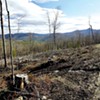Published September 15, 2021 at 10:00 a.m. | Updated September 16, 2021 at 12:37 p.m.
Mass. Tax
I am an out-of-stater who visits your area often. I am impressed with the people and atmosphere every time I visit.
I was very surprised by this article ["Tax Burdened," August 18], though. I have been in the real estate field since 1996 and am familiar with increases in taxes and abatements. Here is what I have been saying for years: No one has an issue with paying taxes to keep their community open at the local, state or federal branch.
The tax increases are based on a millage rate and the valuation of your property. I have never heard of waiting 16 years to reassess property. In addition, I have no idea why Burlington City Hall hired a separate company to conduct these reassessments. What are the city assessors doing, and why would this process take until December? Crazy. In Massachusetts, this process is start-to-finish each January.
What is the real cost to keep communities open? Folks, your taxes are also feeding the massive and numerous public employee pension funds. After 30 years on the job, a retired public employee receives 80 percent of their final salary every year with cost-of-living increases. Look it up. How many are on this program today? This is what is driving taxes so high.
Vermonters are great at getting things changed. You are looked up to in this country. The public retirement program is what Vermont should focus on changing next. And your U.S. Sen. Bernie Sanders should, too.
Chris Bloom
Hadley, MA
Letter to the Council
Dear Burlington City Councilors: We do not need a new municipal department for waste management ["Dumpster Divining," July 28]. If you're itching to ask the public for bond funding, make it for a new high school, not this. Priorities, please.
As for the "hybrid option," I have a trash/compost hauler I am very happy with, and I don't believe that the city can actually do better on price — not when the far-from-incidental costs, such as creating several new full-time positions, are factored in. It's also unclear whether the hybrid option would actually reduce the number of trucks. It is, however, likely to put some smaller composting startups out of business or force them to go farther afield for customers. (So much for lowered emissions and traffic.)
Please focus on the truly critical things that need your undivided attention right now. Those issues are as follows: 1) Find funding and community support for a new high school and tech center; 2) address the deteriorating safety of our city (including but not limited to the spate of recent gunfire incidents, one of which shut down the Edmunds campus on its third day of school); and 3) tackle the increasingly egregious price tag of living in this city, for renters and homeowners alike — a problem that has been greatly exacerbated by the recent botched, amateurish and arbitrary citywide property reappraisal.
Those three "must-address" issues should keep you plenty busy. Once those have been dealt with, you can turn your attention to the "nice-to-have" items.
Nelson Caldwell
Burlington
15 Years and Counting
Thanks to Fair Game ["The Deluge Problem," August 18] for explaining how fossil-fueled climate catastrophe is making Lake Champlain cleanup more difficult and expensive. This timely reporting coincides with the end of another record-breaking summer of heat, wildfire and drought. Yet the connection between climate change and lake pollution is not new information.
Fifteen years ago, Conservation Law Foundation successfully sued the federal Environmental Protection Agency — and, by extension, the Vermont Agency of Natural Resources — over the weak framework for lake cleanup. The legal complaint explained that these government officials "completely failed to consider then-existing, widely-known, peer-reviewed scientific findings demonstrating an ongoing and increasing trend of accelerated climate change," including "then-occurring and predicted climate change-induced changes in precipitation and their effect on the magnitude and timing of runoff, increasing pollutant loads flushed into waters from failing or overwhelmed waste management systems," and more.
Back in 2006, Vermont ANR officials fiercely opposed CLF over these issues. Sadly, ANR Secretary Julie Moore's more recent acknowledgment that climate change challenges lake cleanup has not translated into a sense of urgency when it comes to clamping down on major pollution sources, such as foul runoff from dairy operations, commercial strip development and municipal storm drain discharge pipes.
Meanwhile, ANR has been overly aggressive in placing ever more hurdles in the way of renewable energy projects that will help Vermont do its share to slow climate change and build a more secure electrical grid powered with homegrown energy.
In the struggle to clean up the lake and create climate solutions, actions speak louder than words.
Anthony Iarrapino
Montpelier
Iarrapino is a former senior attorney for the Conservation Law Foundation.
Forest Plan Is Outdated
Standing Trees Vermont would like to thank Kevin McCallum for his reporting and Seven Days for publishing the article "Clear-Cut? Climate Crisis Spawns a Push to Ban Logging in the Green Mountain National Forest" [August 18]. It is important that Vermonters know about the increased logging in our Green Mountain National Forest.
We would like to clarify how much of our Green Mountain National Forest is being slated for logging. The four most recently approved U.S. Forest Service plans — South of Route 9 Integrated Resource Project, Rochester Integrated Resource Project, Early Successional Habitat Creation Project and the Somerset Integrated Resource Project — have approved logging of more than 43,000 acres. This is 10 percent of the roughly 400,000 acres of our Green Mountain National Forest. And this does not include other previously approved plans and the upcoming Telephone Gap Integrated Resource Project.
All these plans are being approved based on the 2006 Green Mountain National Forest's Forest Management Plan. Per the National Forest Management Act, this plan is out of date. It does not include current science related to the importance of forests for biodiversity, carbon sequestration, clean water and their ability to reduce the impacts of extreme weather events projected to increase with climate change, protecting communities from natural disasters.
If others are interested in joining our efforts to have the U.S. Forest Service change its management approach for our Green Mountain National Forest, they can reach us at our website, standingtreesvermont.org.
Mark Nelson
Ripton
Nelson is a member of Standing Trees Vermont.
Dearth of Data on Forests
Thanks for some excellent reporting on the upcoming Telephone Gap project in the Green Mountain National Forest ["Clear-Cut?" August 18]. There are a lot of interesting pieces to this issue, from climate change and changing forestry science to federal-level governance and the solvency (or not) of Vermont's "working landscapes."
When I reported on the issue this spring for the Herald of Randolph, I was surprised to find how little data was readily available on timber harvests. After all, this is public land, and the U.S. Forest Service prides itself on making decisions using detailed, site-specific analyses. Both the district ranger and the forest supervisor, though, said they did not have information on how much harvest volumes, acreage or road building had changed, and the publications they referred me to didn't, either. I eventually found links to spreadsheets in an April report on road building that had records of every harvest since 1996. They projected harvest areas for the coming decade to be 218 percent higher and volumes to be up almost 440 percent compared to 1996 through 2005. Perhaps more interestingly, they listed "Gary's memory" as the ultimate source of much of the information.
Neither the difficulty of finding these figures nor the informal nature of the record keeping inspires confidence in the process behind GMNF management. The issue of how and whether to harvest timber on public lands is more complex than an outright logging ban, but the public deserves a robust process that begins with access to better and more complete information.
Chris Gish
Burlington
Harvest Helps
[Re "Clear-Cut?" August 18]: The Seven Days story about a group protesting harvesting on the Green Mountain National Forest in Vermont did not give clear voice to the broader viewpoint. I'm sure the small group of hard-core anti-timber folks is upset, because the national forest managers are doing a fine job managing forests that have not been taking a beating. A harvest is not pretty at first; however, five, 10, or 20 years or more later, the vigorous growth of brush and trees and the support of wildlife are beautiful to see. That gets little attention or credit from the anti-harvest side.
Roughly half the national forest in Vermont is wilderness or managed nearly like wilderness, pleasing the anti-timber folks, who also misrepresent road and phosphorus data. The national forest exists for all of us, not just for those whose vision is too narrow to see that timber harvesting is an important part of our history and a clearly sustainable part of our future.
We should be considering the role that timber harvesting plays in the economy, along with the environmental benefits of timber harvesting. Fact: We harvest less than half the annual growth of timber in Vermont. That represents a huge plus for Vermont, solidly on the positive side in storing carbon in trees and in products made from responsibly harvested timber. We need the national forest managers to continue doing what they are so good at: demonstrating outstanding forest management, experimenting with new techniques and, like all forest managers, thinking for the long term.
Kenneth Johnson
Bristol
'I Spys' Are Gross
[Re Feedback: "Why 'Spy'?" August 18]: I couldn't agree more with Kayla Woodman.
You say you encourage readers to be respectful, yet you allowed someone to post "Do I need to teach you how to use your manners?" after their first post was left unanswered? Does not sound respectful at all to me.
I'd be curious to know how many people enjoy being spied, because every person I know who's ever been spied ends up fearing a little bit more for their safety.
If you really want to keep "I Spy" up and running, why don't you allow just clothing and hair descriptions, time and place. Allowing people to objectify others' bodies while they're out for a jog or at work is gross. Do better.
As for the post in question, I don't think it's a coincidence that I never see my favorite cashier at the co-op ever since the first "Spy" about them.
Allison Sawyer
Brandon
Night Shift, Anyone?
Perhaps if doctors and staff worked around the clock, the backlog would get taken care of ["The Doctor Won't See You Now," September 1]. When I worked at Dartmouth-Hitchcock medical center, the majority of nurses and support staff left to go home before 5 p.m. The hospital appeared empty compared to the a.m. I'm sure patients would take a 10 p.m. appointment if it meant they could be seen in a timely manner. Think so?
Raymond Dauphinais
Brownington
More Moratoriums
I wish I were as "cautiously optimistic" as Natural Resources Secretary Julie Moore that PFAS chemicals are not migrating from Vermont into Québec and contaminating the water supplies of Canadians [Off Message: "Vermont Extends Ban on Dumping 'Garbage Juice' in Lake Memphremagog," August 25]. I was at the same meeting as reporter Kevin McCallum on August 24, and I heard nothing in the data presented that suggested that optimism is warranted. This summer's data merely provide a baseline going forward.
Leachate has not been directly disposed of into Newport's wastewater treatment facility (incapable of filtering PFAS or other leachate toxins) since October 2019, almost two years ago. It takes about two years for water from one end of the lake to flow to the other.
It is entirely conceivable that PFAS detected in Sherbrooke's drinking supply months ago originated from leachate disposed of in Newport's wastewater treatment facility prior to the moratorium imposed on that practice. More reason for the current moratorium on "leachate disposal or treatment anywhere in the Memphremagog watershed" to be made permanent — which would require this proposed "five-year pilot treatment project" to be undertaken outside the Memphremagog watershed, as well.
Peggy Stevens
East Charleston
More By This Author
Comments
Comments are closed.
From 2014-2020, Seven Days allowed readers to comment on all stories posted on our website. While we've appreciated the suggestions and insights, right now Seven Days is prioritizing our core mission — producing high-quality, responsible local journalism — over moderating online debates between readers.
To criticize, correct or praise our reporting, please send us a letter to the editor or send us a tip. We’ll check it out and report the results.
Online comments may return when we have better tech tools for managing them. Thanks for reading.














































